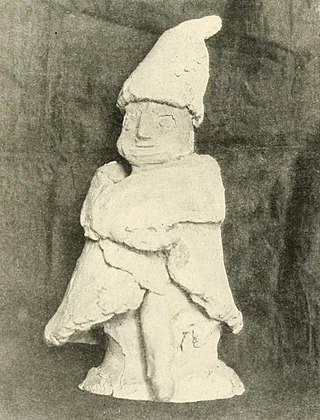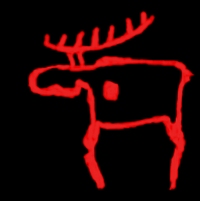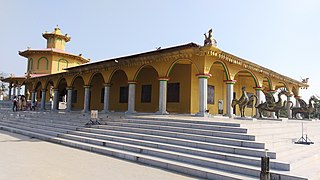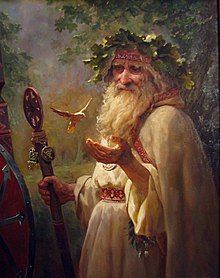
In European folklore of the medieval and early modern periods, familiars were believed to be supernatural entities or spiritual guardians that would protect or assist witches and cunning folk in their practice of magic. According to records of the time, those alleging to have had contact with familiar spirits reported that they could manifest as numerous forms, usually as an animal, but sometimes as a human or humanoid figure, and were described as "clearly defined, three-dimensional... forms, vivid with colour and animated with movement and sound", as opposed to descriptions of ghosts with their "smoky, undefined form[s]".
Prav (Правь), Yav (Явь) and Nav (Навь) are the three dimensions or qualities of the cosmos as described in the first chapter of the Book of Light and in the Book of Veles of Slavic Native Faith (Rodnovery). Older sources mention only Nav and Yav concepts of ancient slavic cosmology, similar to Yin and Yang in Taoism, and Prav was not part of the concept. The literal meanings of the Prav, Yav, and Nav words, are, respectively, "Right", "actuality" and "probability". They are also symbolised as a unity by the god Triglav. Already Ebbo documented that the Triglav was seen as embodying the connection and mediation between Heaven, Earth and the underworld / humanity; these three dimensions were also respectively associated to the colours white, green and black as documented by Karel Jaromír Erben.

Slavic mythology or Slavic paganism is the religious beliefs, myths, and ritual practices of the Slavs before Christianisation, which occurred at various stages between the 8th and the 13th century.

A household deity is a deity or spirit that protects the home, looking after the entire household or certain key members. It has been a common belief in paganism as well as in folklore across many parts of the world.

Finnic paganism was the indigenous pagan religion in Finland, Karelia, Ingria and Estonia prior to Christianisation, the religion was native to the Baltic Finnic peoples. It was a polytheistic religion, worshipping a number of different deities. The principal god was the god of thunder and the sky, Ukko; other important gods included Jumo (Jumala), Ahti, and Tapio. Jumala was a sky god; today, the word "Jumala" refers to all gods in general. Ahti was a god of the sea, waters and fish. Tapio was the god of forests and hunting.

Celtic neopaganism refers to any type of modern paganism or contemporary pagan movements based on the ancient Celtic religion. One approach is Celtic Reconstructionism (CR), which emphasizes historical accuracy in reviving Celtic traditions. CR practitioners rely on historical sources and archaeology for their rituals and beliefs, including offerings to spirits and deities. Language study and preservation are essential, and daily life often incorporates ritual elements. While distinct from eclectic pagan and neopagan witchcraft traditions, there is some overlap with Neo-druidism.

The Native Polish Church, or Native Church of Poland is a West Slavic pagan religious association that adverts to ethnic, pre-Christian beliefs of the Slavic peoples. The religion has its seat in Warsaw, with local temples throughout the country.

A volkhv or volhv is a priest in ancient Slavic religions and contemporary Slavic Native Faith.

The Tai folk religion, Satsana Phi or Ban Phi is the ancient native ethnic religion of Tai people still practiced by various Tai groups. Tai folk religion was dominant among Tai people in Asia until the arrival of Buddhism and Hinduism. It is primarily based on worshipping deities called Phi, Khwan and Ancestors.

Gut are the rites performed by Korean shamans, involving offerings and sacrifices to gods, spirits and ancestors. They are characterised by rhythmic movements, songs, oracles and prayers. These rites are meant to create welfare, promoting commitment between the spirits and humankind. The major categories of rites are the naerim-gut, the dodang-gut and the ssitgim-gut.
In Slavic mythology, a vedmak (Belarusian: вядзьмак, вядзьмар; Bulgarian: вещер; Croatian: vještac; Czech: vědmák; Macedonian: вештер; Polish: wiedźmak; Russian: ведьмак; Serbian: вештац; Ukrainian: відьмак) is a warlock or male witch, the female equivalent (witch) being vedma, but unlike the latter, the vedmak may also possess positive qualities. This role greatly focuses on the Shamanic aspects of Slavic Paganism.
Black shamanism is a kind of shamanism practiced in Mongolia and Siberia. It is specifically opposed to yellow shamanism, which incorporates rituals and traditions from Buddhism. Black Shamans are usually perceived as working with evil spirits, while white Shamans with spirits of the upper world.

Ynglism, institutionally the Ancient Russian Ynglist Church of the Orthodox Old Believers–Ynglings, is a white nationalist branch of Slavic paganism formally established in 1992 by Aleksandr Yuryevich Khinevich in Omsk, Russia, and legally recognised by the Russian state in 1998, although the movement was already in existence in unorganised forms since the 1980s. The adherents of Ynglism call themselves "Orthodox", "Old Believers", "Ynglings" or "Ynglists".

Kev Dab Kev Qhuas is the common ethnic religion of the Miao people, best translated as the "practice of spirituality". The religion is also called Hmongism by a Hmong American church established in 2012 to organize it among Hmong people in the United States.
Fugara or Fuqara are shaman or people with supernatural powers in Bedouin shamanism. Fugara means 'weak' as these individuals are known to avoid hefty meals. They are masters of desert mysticism and are believed to have access to the spiritual realm. They provide advice, teaching or spiritual insight to entire tribes, along with tending to the sick.
In Slavic Native Faith (Rodnovery) there are a number of shared holidays throughout the year, when important ritual activities are set according to shared calendars. Generally speaking, ritual activities may be distinguished into "external" (exoteric) and "internal" (esoteric) relatively to the different communities. External ceremonies are mass gatherings, usually held on important holidays dedicated to the worship of common gods, and involving large numbers of people. Internal ceremonies are those restricted to specific groups, and holding special meaning for such groups; they may comprise private rituals and worship of specific ancestors.
Slavic Native Faith (Rodnovery) has a theology that is generally monistic, consisting in the vision of a transcendental, supreme God which begets the universe and lives immanentised as the universe itself, present in decentralised and autonomous way in all its phenomena, generated by a multiplicity of deities which are independent hypostases, facets, particles or energies of the consciousness and will of the supreme God itself.
Shamanism is a religious practice present in various cultures and religions around the world. Shamanism takes on many different forms, which vary greatly by region and culture and are shaped by the distinct histories of its practitioners.
Lower mythology is a sphere of mythological representations relating to characters who have no divine status, demons and spirits, as opposed to higher gods and the official cult. This opposition is particularly pronounced in world religions.












